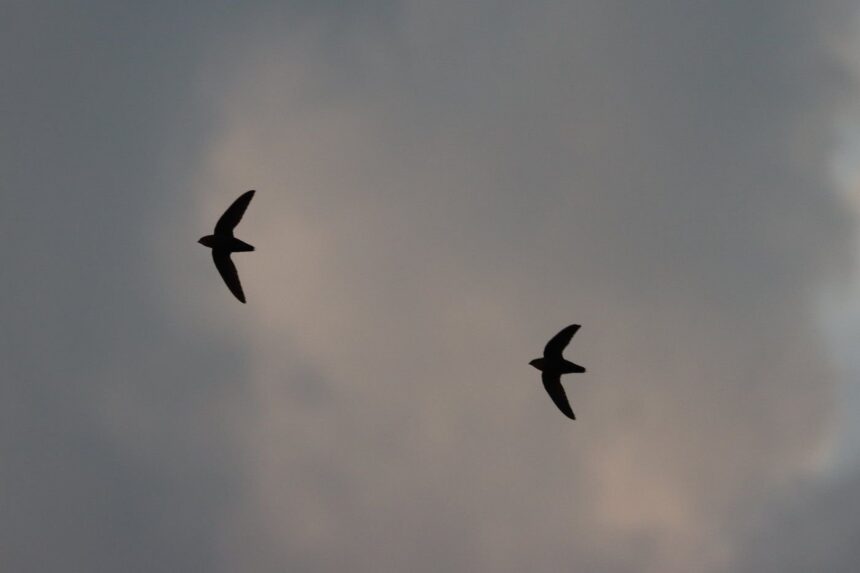An influx of chimney swifts roosting in New Brunswick has raised hopes among conservation experts that the threatened bird species may be staging a comeback in Atlantic Canada.
Over the past week, local birdwatchers and conservationists have documented more than 2,300 of the small, acrobatic birds funneling into a single chimney in Fredericton during evening roosting sessions. This represents one of the largest concentrations of chimney swifts observed in the province in recent decades.
“It’s breathtaking to witness,” says Dr. Melissa Thompson, an ornithologist with the Atlantic Wildlife Federation who has studied the species for eleven years. “The birds circle above like a living tornado before diving into the chimney at dusk. What makes this truly remarkable is the sheer number we’re seeing this spring.”
Chimney swifts, recognized by their cigar-shaped bodies and rapid, chattering calls, have faced steep population declines across Canada since the 1970s. The Committee on the Status of Endangered Wildlife in Canada (COSEWIC) designated them as threatened in 2007, a status that remains unchanged today.
The birds’ decline has been linked to several factors. Traditional roosting and nesting sites in old-growth hollow trees have largely disappeared with forest practices, and modernization of heating systems has eliminated many suitable chimneys. Additionally, the drop in flying insect populations—the swift’s primary food source—has reduced their available prey.
Local conservation volunteer James MacKenzie has been counting swifts at the Fredericton site for seven consecutive evenings. “We started noticing unusual numbers in mid-May, but what we’re seeing now is unprecedented,” MacKenzie explains. “Last year at this same location, the highest count was just under 800 birds.”
The roosting chimney belongs to an historic building near the St. John River that has remained unchanged for decades. Its brick structure and large diameter create ideal conditions for the birds, which cling to vertical surfaces with specialized claws rather than perching like other bird species.
Provincial wildlife officials are cautiously optimistic about what the influx might mean. “One good season doesn’t reverse the long-term trend, but it gives us hope,” says Emma LeBlond, species at risk coordinator with the New Brunswick Department of Natural Resources. “We’re seeing the benefits of coordinated conservation efforts across the province.”
Those efforts include education campaigns asking building owners to delay chimney cleaning until after nesting season and the installation of artificial chimney swift towers in areas where natural habitat has been lost. Since 2018, community groups have constructed eleven such towers across the province, three of which have successfully attracted nesting pairs.
Data from Environment and Climate Change Canada shows chimney swift populations have declined by approximately 95% since the early 1970s, making every roosting site critically important. The birds spend winters in the upper Amazon basin of South America before making their remarkable migration north each spring.
Dr. Thompson believes several factors may explain this year’s higher numbers. “We’ve had favorable southern winds during migration, which helps the birds on their journey north. There’s also been a noticeable increase in flying insects this spring due to our wet conditions. But most importantly, I think we’re seeing the cumulative impact of conservation work.”
Local residents have embraced the birds’ return. The Fredericton Swift Watch, a citizen science initiative, has drawn dozens of observers to evening viewings. Nine-year-old Lily Haché attended with her family last weekend. “They move so fast you can barely see them, then suddenly they’re gone into the chimney. It’s like magic,” she says.
The swift’s aerial abilities are indeed remarkable. The birds spend nearly their entire lives in flight, even collecting nesting materials by breaking twigs off trees while flying. They can reach speeds of 170 kilometers per hour and have been documented sleeping while airborne.
For conservationists like Thompson, the recent observations provide motivation to continue protection efforts. “These birds have adapted to human structures after losing their natural habitat, which shows their resilience. But they still need our help.”
Officials are asking property owners to report active swift roosting sites and consider chimney modifications that would make them more swift-friendly, such as installing metal caps that still allow bird access while preventing water damage.
The provincial government has allocated $75,000 this year toward chimney swift habitat conservation, including a program that provides matching funds to building owners who maintain swift-friendly chimneys.
As evening approaches in downtown Fredericton, a small crowd gathers near the historic building. Cameras and binoculars point skyward as the first few swifts appear, circling higher and higher above the chimney. Their numbers grow steadily over thirty minutes until the sky fills with darting, chittering birds.
Then, as if responding to an unseen signal, they begin to pour into the chimney in a counterclockwise spiral. The spectacle lasts barely five minutes before the last swift disappears into the brick column, leaving behind only the memory of their remarkable journey and the hope that these threatened birds might be finding their way back from the brink.






